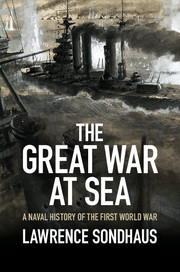Book contents
- Frontmatter
- Contents
- List of figures
- List of maps
- Acknowledgments
- Introduction
- 1 Ambition, ideology, and arms races
- 2 Preparing for war
- 3 Global prelude
- 4 European waters, 1914–15
- 5 Submarine warfare: The great experiment, 1915
- 6 Combined operations, 1915
- 7 The year of Jutland: Germany’s fleet sorties, 1916
- 8 Submarine warfare: The great gamble, 1917–18
- 9 War and revolution, 1917
- 10 Final operations
- Conclusion: Peace and naval disarmament
- Bibliography
- Index
- References
8 - Submarine warfare: The great gamble, 1917–18
Published online by Cambridge University Press: 05 August 2014
- Frontmatter
- Contents
- List of figures
- List of maps
- Acknowledgments
- Introduction
- 1 Ambition, ideology, and arms races
- 2 Preparing for war
- 3 Global prelude
- 4 European waters, 1914–15
- 5 Submarine warfare: The great experiment, 1915
- 6 Combined operations, 1915
- 7 The year of Jutland: Germany’s fleet sorties, 1916
- 8 Submarine warfare: The great gamble, 1917–18
- 9 War and revolution, 1917
- 10 Final operations
- Conclusion: Peace and naval disarmament
- Bibliography
- Index
- References
Summary
On July 29 of the war’s last year, at the railway station in Elberfeld, near Wuppertal on the fringe of the Ruhr, two German submarine officers exchanged farewells after spending two days with friends on leave. They had entered the navy in 1910 and had been Naval School classmates; now, aged twenty-six, both were veterans of four years of war and held the rank of Oberleutnant. As they parted ways, Hans Jochen Emsmann boarded a train for occupied Flanders and a U-boat command at Zeebrugge, while his friend on the platform, Martin Niemöller, would soon return to the Adriatic and his own U-boat command at Pola. The disastrous, irreversible breakdown of Germany’s Western front at Amiens – on what Ludendorff called “the black day of the German army” – was still a week and a half away, but both Emsmann and Niemöller had experienced enough to know that the prospects for victory were no longer very good, even though U-boats had sunk nearly 8 million tons of Allied shipping in the eighteen months since the resumption of unrestricted submarine warfare. At the close of what Niemöller remembered as “a serious talk about the general situation,” Emsmann’s mood suddenly shifted to an exculpatory light-heartedness: “If the war is lost, it will certainly not be due to anything you and I have done!” he assured his friend.
Emsmann died three months later, when his U 116 sank with all hands on a suicidal attempt to infiltrate the harbor at Scapa Flow in the war’s last days. Niemöller died in 1984 at the age of ninety-two, after becoming more famous for his second career as a Protestant pastor and survivor of eight years’ imprisonment in concentration camps for his principled condemnation of Nazi Aryan racism. Through all that came afterward, Emsmann’s words remained with him, and for Niemöller, ever the patriotic German, they rang true. But the irony, for Germany, was that they and other U-boat commanders did their duty all too well. The war, indeed, would be lost, with the intervention of the United States and its massive reservoir of fresh manpower the key to the Allied victory. At the Armistice, 1.4 million American troops stood on the Western front, where their numbers had long since exceeded the French and, in the war’s last days, grew to surpass the total number of British and Imperial troops.
- Type
- Chapter
- Information
- The Great War at SeaA Naval History of the First World War, pp. 241 - 277Publisher: Cambridge University PressPrint publication year: 2014



